AMD Ryzen 5 1600 AF Benchmarks
For this exercise, we are using our legacy Linux-Bench scripts which help us see cross-platform “least common denominator” results we have been using for years as well as several results from our updated Linux-Bench2 scripts. Starting with our 2nd Generation Intel Xeon Scalable benchmarks, we are adding a number of our workload testing features to the mix as the next evolution of our platform.
At this point, our benchmarking sessions take days to run and we are generating well over a thousand data points. We are also running workloads for software companies that want to see how their software works on the latest hardware. As a result, this is a small sample of the data we are collecting and can share publicly. Our position is always that we are happy to provide some free data but we also have services to let companies run their own workloads in our lab, such as with our DemoEval service. What we do provide is an extremely controlled environment where we know every step is exactly the same and each run is done in a real-world data center, not a test bench.
We are going to show off a few results, and highlight a number of interesting data points in this article.
Python Linux 4.4.2 Kernel Compile Benchmark
This is one of the most requested benchmarks for STH over the past few years. The task was simple, we have a standard configuration file, the Linux 4.4.2 kernel from kernel.org, and make the standard auto-generated configuration utilizing every thread in the system. We are expressing results in terms of compiles per hour to make the results easier to read:
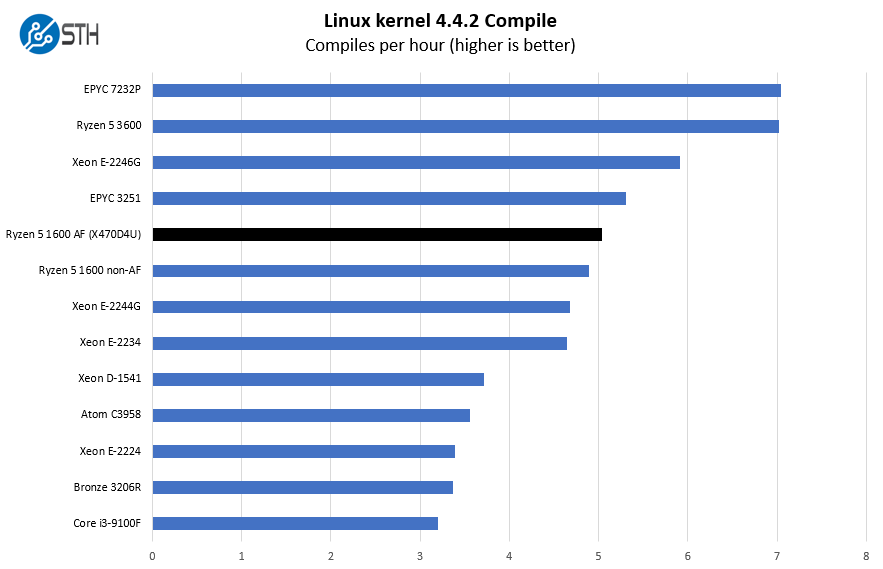
We tried getting a sample set that crosses a decent spectrum of alternatives to give some anchor points. Some of the comparisons are a bit odd. For example, the AMD EPYC 7232P costs around 5x as much but enables a massively bigger and more robust platform. Likewise, the Intel Xeon Bronze 3206R is not the fastest Intel Xeon chip, nor one we recommend for performance, but it is the lowest cost part from the latest Big 2nd Gen Intel Xeon Scalable Refresh. The Intel Xeon Bronze 3204 is a closer price competitor but both have significantly more robust platforms.
c-ray 1.1 Performance
We have been using c-ray for our performance testing for years now. It is a ray tracing benchmark that is extremely popular to show differences in processors under multi-threaded workloads. We are going to use our 8K results which work well at this end of the performance spectrum.
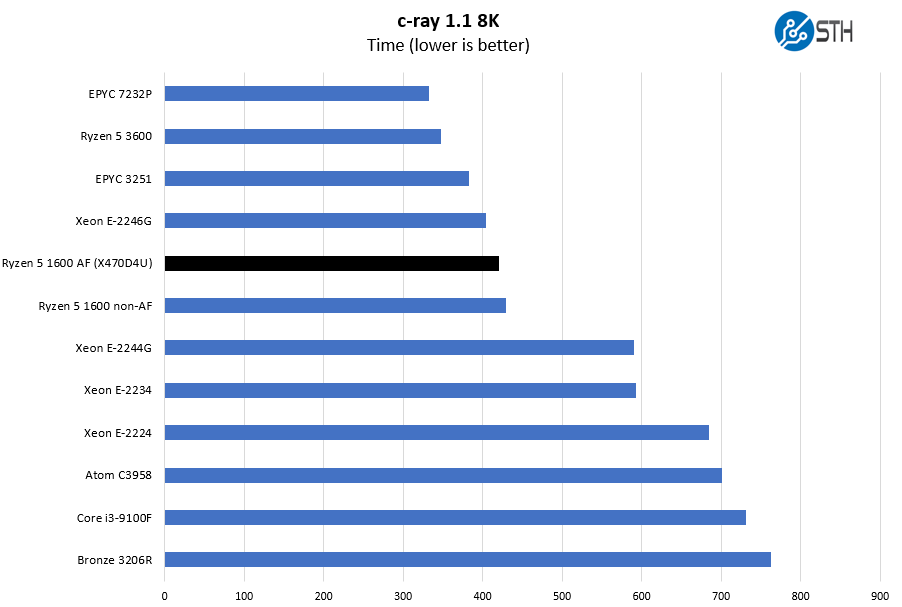
Here we can see c-ray 8K results that are solid. Performance of AMD Zen, Zen+, and Zen 2 chips tend to be great on this type of benchmark.
7-zip Compression Performance
7-zip is a widely used compression/ decompression program that works cross-platform. We started using the program during our early days with Windows testing. It is now part of Linux-Bench.
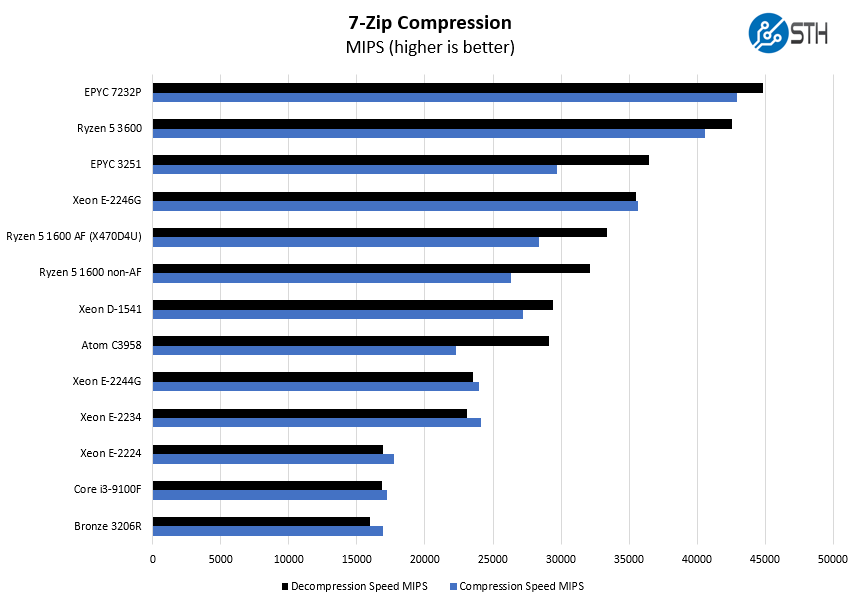
As you are going to see, the Ryzen 5 1600 AF performs somewhere between a 4 core and a 6 core Intel Xeon E-2200 series processor. Again, the Xeon E-2200 series CPUs that bookend this performance cost twice as much if not more than that. The Intel CPUs also tend to perform better on the compression side but we have been sorting this benchmark by decompression speed for years.
NAMD Performance
NAMD is a molecular modeling benchmark developed by the Theoretical and Computational Biophysics Group in the Beckman Institute for Advanced Science and Technology at the University of Illinois at Urbana-Champaign. More information on the benchmark can be found here. Here are the comparison results for the legacy data set:
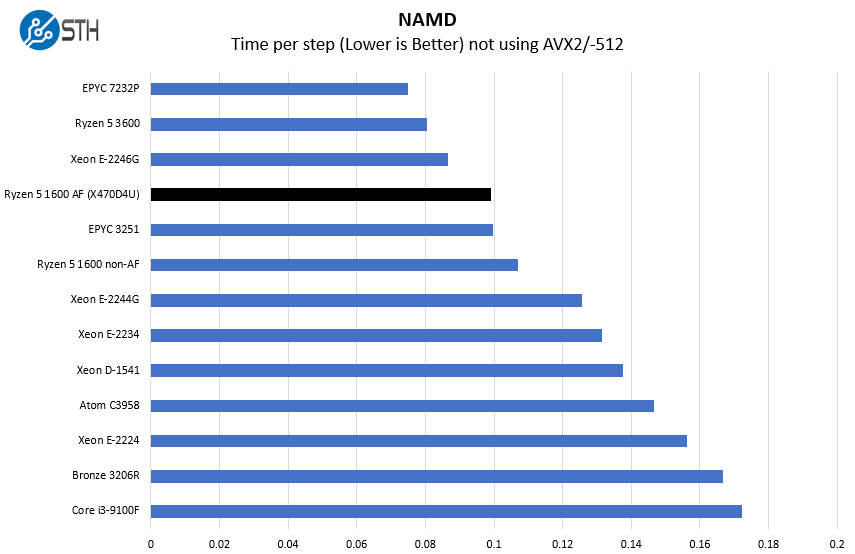
With higher clock speeds, the Ryzen 5 1600 AF is able to compete well with single-die EPYC 3000 series processors such as the AMD EPYC 3251. If one moves up the stack to the AMD EPYC 3351 the sheer number of cores make the EPYC 3000 series faster.
Sysbench CPU test
Sysbench is another one of those widely used Linux benchmarks. We specifically are using the CPU test, not the OLTP test that we use for some storage testing.
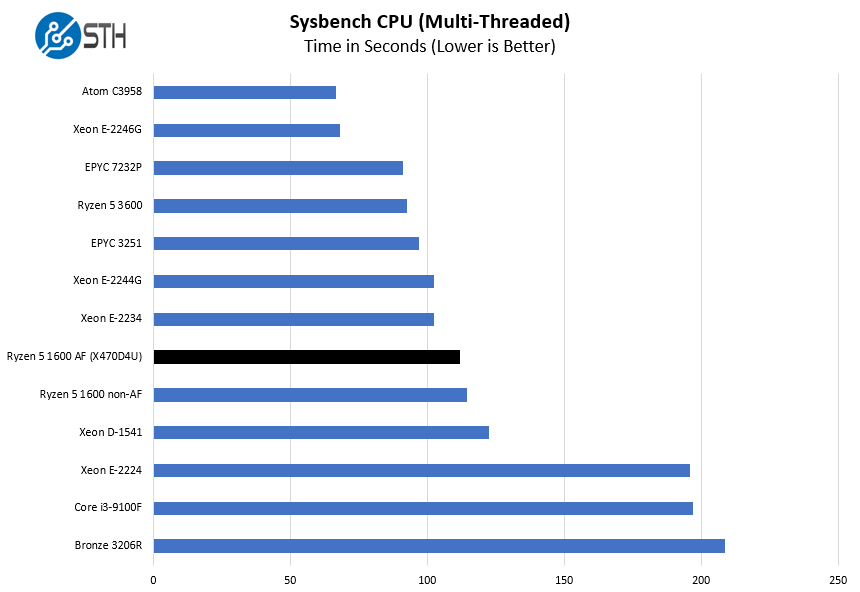
Perhaps the most direct competition on the Intel side comes from the Core i3-9100F. That SKU does not have an GPU and has a similar cost. In its new 10th Gen Intel Core Series, Intel is raising the price of the Core i3 entry parts by 26% which will make them more expensive but with significantly higher performance due to hyper-threading.
OpenSSL Performance
OpenSSL is widely used to secure communications between servers. This is an important protocol in many server stacks. We first look at our sign tests:
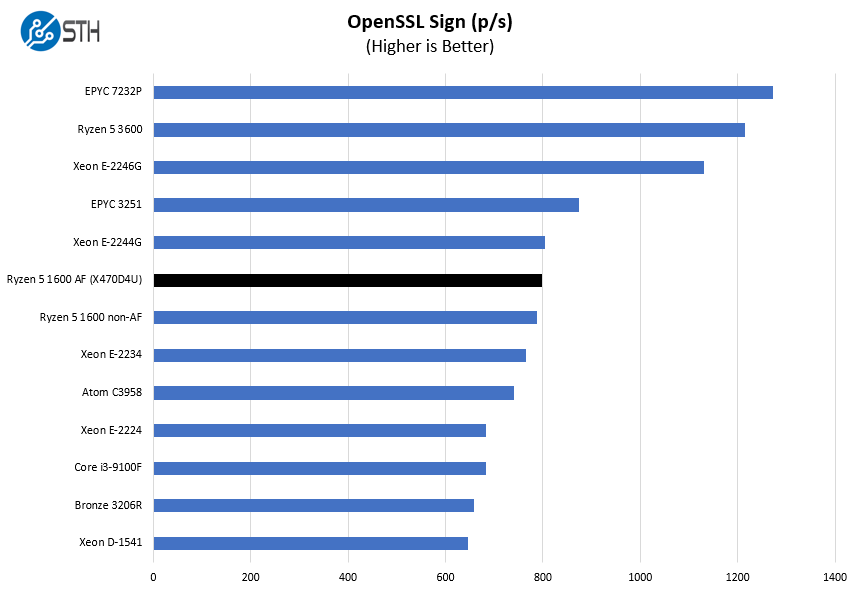
Here are the verify results:
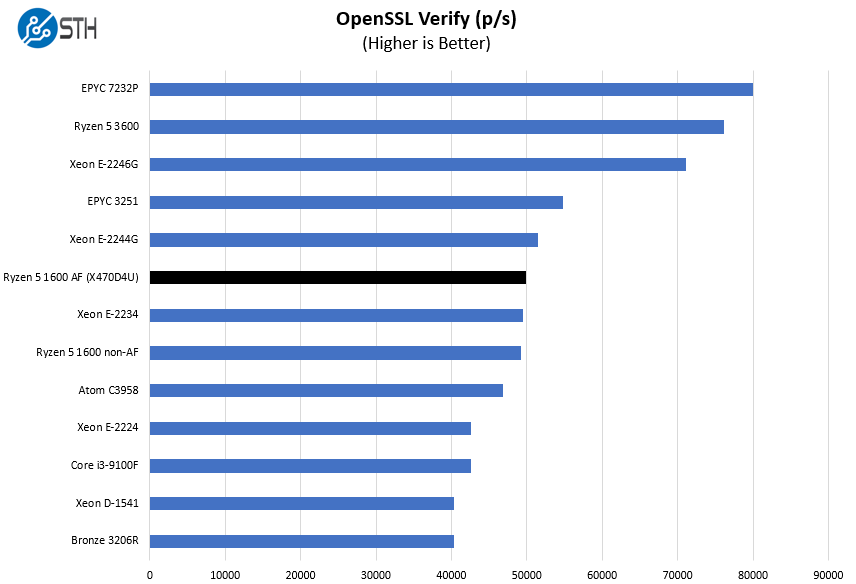
Here we can see results just below the Intel Xeon E-2244G. Intel’s higher clock speeds mean it is performing well here. The Xeon E-2244G is a $272 list price part but has an iGPU. Still, that is a massive price delta.
UnixBench Dhrystone 2 and Whetstone Benchmarks
Some of the longest-running tests at STH are the venerable UnixBench 5.1.3 Dhrystone 2 and Whetstone results. They are certainly aging, however, we constantly get requests for them, and many angry notes when we leave them out. UnixBench is widely used so we are including it in this data set. Here are the Dhrystone 2 results:
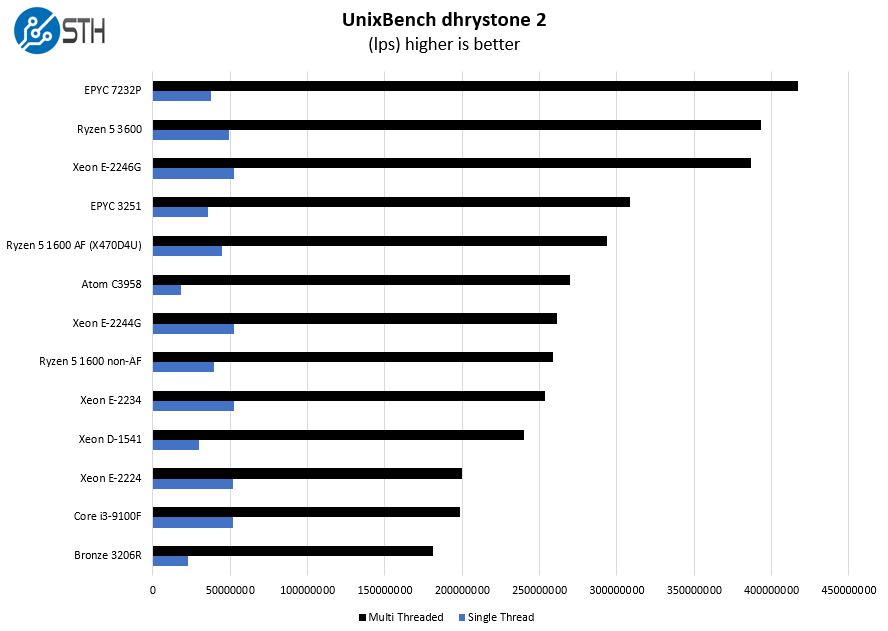
Here are the whetstone results:
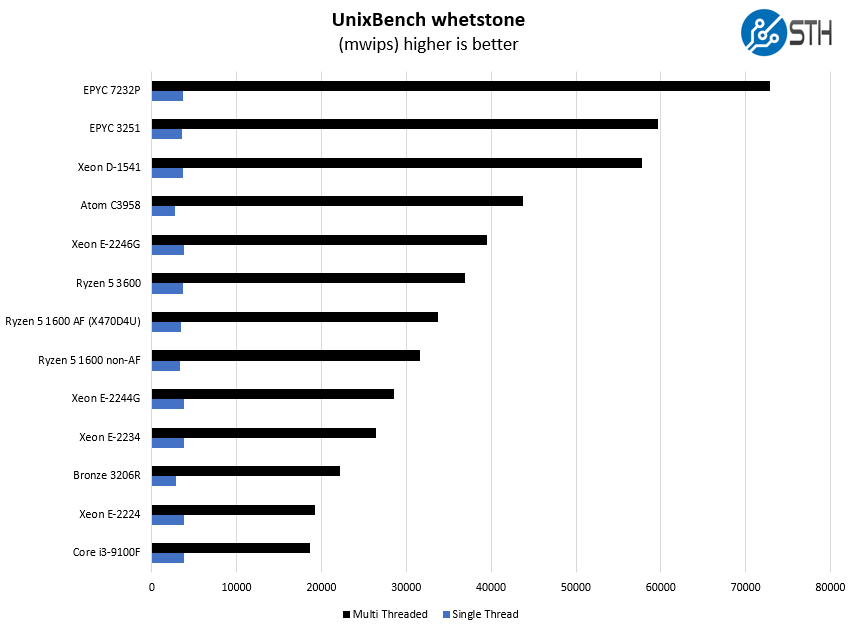
Compared to embedded parts such as the Intel Xeon D-1541 and Intel Atom C3958 the Ryzen 5 1600 AF offers much of the same performance depending on the workload, but at a much lower cost. One trades BGA for a socket and higher TDP with the Ryzen part.
Chess Benchmarking
Chess is an interesting use case since it has almost unlimited complexity. Over the years, we have received a number of requests to bring back chess benchmarking. We have been profiling systems and now use the results in our mainstream reviews:
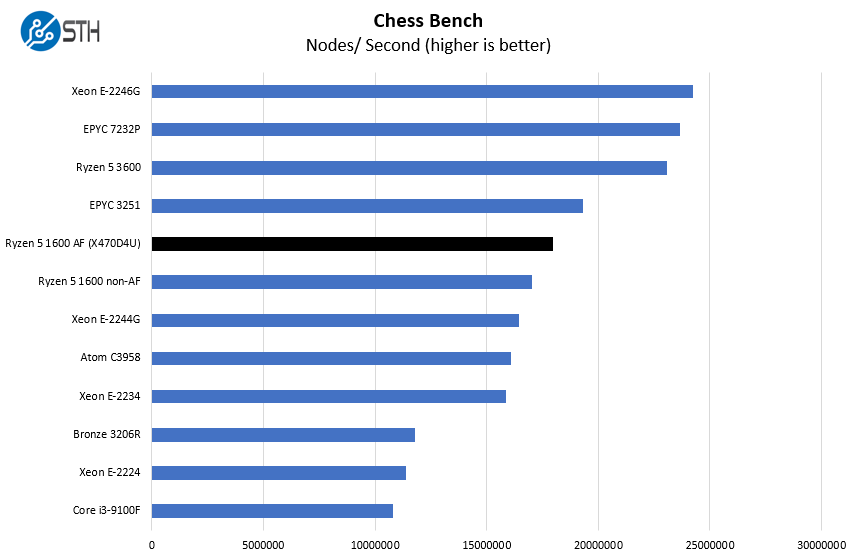
While we see a consistent performance uplift over the non-AF version, we can also see that the new AMD Ryzen 5 3600 is much faster in the ASRock Rack X470 platform. Overall, we think that most people in the market for a Ryzen server-style platform are going to find the AF more attractive since the price/ performance is a lot better. Of course, there is a lot of room to scale and the Ryzen 5 3600 starts showing where that scaling will start.
Next, we are going to take a look at some of the market dynamics before getting to our final words.




John,
Why didn’t you include a Ryzen 5 2600 in the mix?
The 1600 AF is often likened to a 2600 from a performance point of view.
I’d like to have seen the 16c Ryzen. BinkyTo I don’t see the point of the 2600. The 1600AF is so close and the 3600 is newer and better at the price. Maybe for completeness but I can’t see buying a 2600 over a 1600AF or 3600.
BinkyTo and Nate77,
I am reviewing the X470D4U class boards, and ran the benchmarks for this article. The trio of CPUs we had available to us were the original 1600, the 1600 AF, and the 3600; the idea being to cover each of the three Zen generations and simply make sure all was well from a software compatibility standpoint. Performance can scale up (or down) with core count if you move away from the 6C solutions within any of the three generations of the Ryzen CPUs, so we wanted to make sure that all three generations were tested.
It’s a bit like iOS it’s not supported by the big server vendors such as Dell EMC, HPE, Inspur, and Lenovo and when your server workloads depends on vendors like Dell EMC, HPE, Inspur, Lenovo and Apple you know that your in deep sh*t. It’s a bit like when your IT depends on ORACLE. It’s a good thing that companies like AsRock, Gigabyte, Tyan, etc.. give us the opportunity to not be in the hands of corporate companies like the NSA and CIA(Cisco and Juniper) or Intel, Dell EMC, HPE, Inspur, Huawei, Lenovo, Apple etc.., with these big brands you are in certified sh*t.
Just completed a new build with E2246G. Software vendor support was main reason why I chose intel. Though I may consider a pfsense box with this CPU.
Gee whiz. If you were writing an article about a jellied eel, you’d still start the wrap up page with “These chips are not released in a vacuum instead, they have competition on both the Intel and AMD sides.”.
“ ASRock Rack has an X570 version of this Ryzen server platform coming, but the chipset uses much more power.”
So we’re getting a X570D4U soon? That’s the first I’ve heard of that.
Ramblinreck47 I think they’re talking about the X570D4I-2T which is the mITX x570 version https://www.asrockrack.com/general/productdetail.asp?Model=X570D4I-2T#Specifications
It isn’t the same, but it’s the successor in x570. I think mITX is better than mATX since it’ll fit more cases.
Personally I would build with a Ryzen 2700E if I could get something like that with integrated graphics. That is one of the reasons the E2176G and E2278G are so compelling, coupled with broad based support for Intel.
jingram, I eagerly await the desktop version of the Renoir 8-core CPU, since removing the need for the additional expense of a GPU should make the AMD solution much more compelling for business class workstations. Plus, assuming the desktop Renoir CPUs use the same die as their mobile counterparts (there is precedent for this in the previous generation APUs) then this future 8-core desktop APU will be a fully monolithic die, rather than chiplet based like the 3rd gen Ryzen 3000 desktop parts. This could result in slight upticks in performance even compared to non-APU processors thanks to reduced intra-die latency.
Very cool review. Obviously the lack of OEM support is going to be an important factor, but with performance and value like this, I hope product managers at OEMs are seriously looking at Ryzen solutions. This kind of media attention should hopefully raise awareness.
It will be interesting to see how this lines up with other sub-$100 AMD cpus like the Athlon 3000G and Ryzen 3 3100.
Ya’ll doing some great stuff STH. Keep at it.
Where do you find an AMD Ryzen 5 1600 AF sold or quoted at $85?
Domih, they are found on Amazon but go in and out of stock every few days.
Unfortunately the current price is almost $150. It would be a monster at the original price.
The price spikes are real. I believe our review unit was purchased for the $85 price around three weeks ago, and I personally purchased another in early April for $90, but they’ve been popular chips and the availability and pricing are suffering as a result.
Too bad these X470 asrock rack boards are unobtainium now
I was surprised to see this combination, the 1600 isn’t on the QVL for ASRock. The CPU I’d like to see is the new ryzen 3300. The low tdp and performance looks promising.
Great review and really, really useful. I’m done my math for such configuration, it is also very useful to have all that CPUs compared on one place. Thanks!
Mike B,
The 1600AF isn’t on the QVL, but the 2600 is and they are essentially the same chip. Plus with the low cost of the 1600AF, we thought it was worth investigating. We actually benchmarked the X470D4U with a 1st gen 1600, the 1600 AF, and the 3600, and all three worked perfectly. The idea was to validate the functionality of all three Zen generations, and the users can extrapolate from those 6-core results to decide if they want more or less cores.
Will the results are definitely compelling.
I’m planning on using this ASRock board in a near future FreeNAS build. At this point I just need to find whether the 1600AF or 3300x makes more sense (cores vs clock).
Mike B,
I’m currently running some FreeNAS testing on this board for an upcoming article, running the Ryzen 5 3600. The next article isn’t about CPU performance so it isn’t the focus of my testing, but I can assure you the 3600 is nearly asleep during my testing. For what I am doing now, I could easily lose 2 of the cores and not be affected.
If you are doing more CPU intensive things like multiple streams of PLEX transcoding, the choice of CPU would perhaps make more difference.
power consumption test?
Does 1600AF consume a lot when it idles?
Could you compare power consumption? e.g. idle
1600AF vs 9100 vs others??
Thanks.
There is no power consumption figures at all, so the article is mostly about nothing.